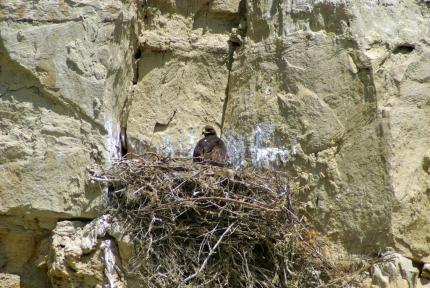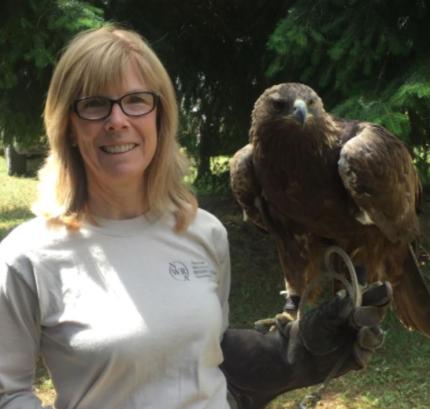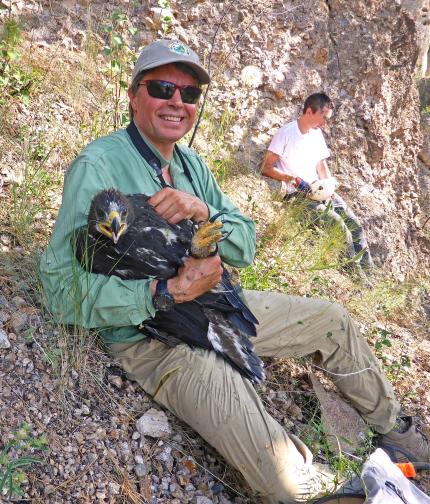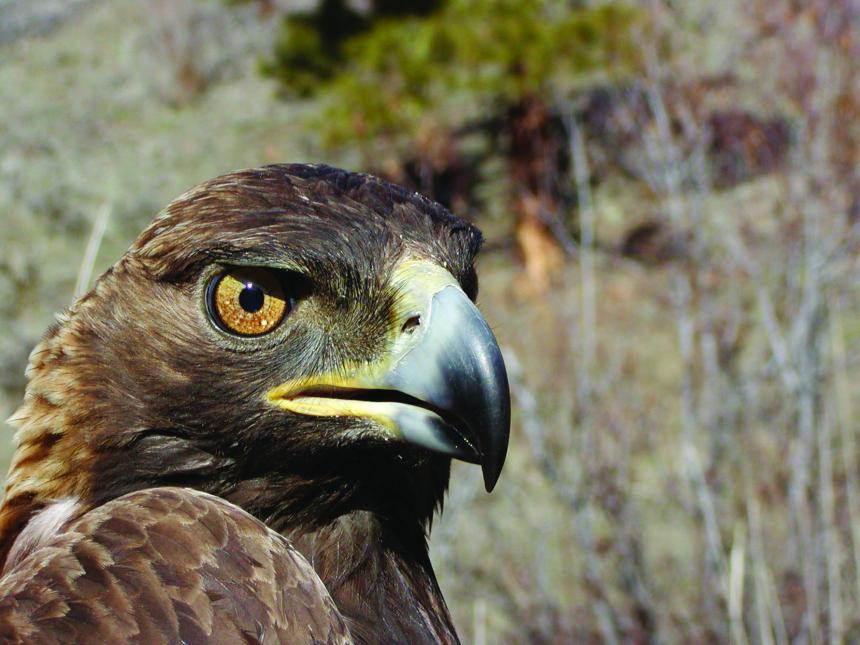Moderate
The population size of golden eagles in Washington is low. This species is of concern due to declines in the distribution and abundance of its primary prey species, jackrabbits and ground squirrels. Across its range, additional mortality factors include continued exposure to lead in the environment and collisions at wind energy facilities.
Description and Range
Physical description
The golden eagle is a large, dark-brown raptor with long, broad wings and a wingspan up to 7 feet. Males and females are similar in appearance, although females average larger. Adults are entirely dark brown except for a golden rear crown, nape, and sides of neck. Gray bars are on the tail, and rear underparts and upperwing coverts are often paler than other feathers, the latter forming a tawny diagonal bar on the upper wing visible both on flying and perched birds. The bill and talons are black-tipped, fading to slate gray near the base. Feet, "cere" (upper beak membrane), and eye ring are yellow. Adult plumage differs from juvenile and immature birds. An immature bald eagle may be confused for an adult golden eagle. The most striking difference involves the distribution of white coloration in the plumage.
Ecology and life history
Washington breeding birds are non-migratory. This species is associated with steep terrain and is found mostly in dry open forests of eastern Washington, shrubsteppe, canyonlands, in high-elevation alpine zones of all regions, and sparingly in clearcut areas in western Washington. Shrublands and grasslands, open meadows, avalanche chutes, talus fields and rock outcrops, balds, bogs, recently burned areas, and clearcuts are used as hunting sites.

Golden eagles hunt for prey in grasslands and shrublands. Preferred prey includes medium to large-sized mammals and birds like hares, rabbits, ground squirrels, and marmots, with mountain beaver being an important prey source in western Washington.
Nests are situated on cliff ledges, rocky outcrops, large trees, or human made structures, such as power poles and transmission towers. Most eastside nests are on cliffs, while westside nests are above timberline or in very large trees that border on extensive clearcuts. Golden eagle nest sites are typically used year after year, and the pair maintains one or more alternate nests in the territory. Nesting success varies by year and region.
Geographic range
Golden eagles have a broad distribution throughout the mountainous areas of the state, especially in eastern Washington. Outside of Washington, golden eagles breed over much of the west from Alaska to northern Mexico and east into the Atlantic Provinces. Outside of North America, they occur through appropriate habitat in Asia, Europe, and parts of Northern Africa.
Washington breeding is limited primarily to the Okanogan highlands, rainshadows of the Olympics and Cascades, the Blue Mountains along the Snake and Grande Ronde rivers, and the San Juan Islands. The resident population occurs at low densities in areas where suitable nest sites (cliffs and trees) are found in proximity to abundant prey. There are over 300 documented breeding territories in Washington, of which over 80 percent are in eastern Washington. Occupancy of these sites is not well understood and information on the number of sites occupied in a given year, as well as an estimate of abundance, are currently lacking.
For a map of range-wide distribution and conservation status of this species, check out NatureServe Explorer.
Climate vulnerability
Sensitivity to climate change
Moderate
Golden eagles may experience some sensitivity to warmer temperatures. For example, nest success and brood size is inversely related to days with temperatures >32˚C. Sensitivity of this species is also influenced by foraging requirements (e.g., prey abundance and habitat), which can affect nest success and ability to lay eggs. Golden eagles prey on hares, rabbits, ground squirrels, prairie dogs, and marmots, among others, and their ability to forage can be negatively affected when prey habitat is lost (e.g., due to wildfires) and/or prey abundance declines.
Exposure to climate change
Moderate
- Increased temperatures
- Altered fire regimes
Regulations
Licenses and permits

Falconry is the art of training raptors (birds of prey - falcons, eagles, hawks, and owls) to hunt in cooperation with a human and is the sport of actively pursuing wild quarry with those birds. The Washington Department of Fish and Wildlife issues falconry permits, regulates the sport, and remains in contact with the falconry community. No one under any circumstances may keep a raptor as a pet. Only licensed falconers may have birds of prey, and these birds must be flown freely and hunt regularly. State and federal regulations, expertise and dedication of falconers, and self-policing by the falconry community keep the birds in high-quality care. Learn more about the history of this sport and the requirements for falconry in Washington.
Conservation
Conservation Threats and Actions Needed

- Agriculture and aquaculture side effects
- Threat: Loss, degradation, and fragmentation of shrupsteppe foraging habitat and associated declines in distribution and abundance of major prey species, especially jackrabbits and ground squirrels.
- Action Needed: Protect and restore shrubsteppe habitat; conservation of prey species.
- Energy development and distribution
- Threat: Collisions at wind energy facilities.
- Action Needed: Implement measures to minimize mortality risks at wind energy facilities.
Humans are the leading cause of golden eagle mortality, either directly or indirectly. A compilation of the causes of 4,300 bald and golden eagle deaths during the early 1960s to mid-1990s found that humans caused more than 70 percent of recorded deaths, with accidental trauma (e.g., collisions with vehicles, power lines, and other structures) being the primary factor (27 percent), followed by electrocution from power lines (25 percent), illegal shooting (15 percent), and lead poisoning from shot prey (6 percent) (Franson et al. 1995). These major threats continue to affect golden eagles today.
See the Climate vulnerability section for information about the threats posed by climate change to the golden eagle.
Our Conservation Efforts
Surveys and monitoring
WDFW and partners have monitored nesting territories in Washington at varying levels of effort since 1990, with more intensive surveys conducted in 1990, 1999, 2000, 2004, and 2005. About 60 breeding pairs of golden eagles were estimated in the state, with about 270 historical breeding territories known. In 2012, several new territories were identified from data collected on golden eagle territories and observations from other agencies in preparation for surveys in 2013.
Resources
References
Bosakowski, T. 2005. Golden eagle (Aquila chrysaetos). Pp 121 – 122 in T. R. Wahl, B. Tweit, and S. G. Mlodinow (eds.) Birds of Washington: Status and Distribution. Oregon State University Press, Corvallis, OR, USA. 436 pp.
Kochert, M. N., K. Steenhof, C. L. McIntyre, and E. H. Craig. 2002. Golden eagle (Aquila chrysaetos). Birds of North America 684: 1-44.
WDFW publications
- A Comparison of Home Range Mapping Techniques for Golden Eagles in Washington
- Range Use and Contaminants of Golden Eagles in Washington: Progress Report 3 (2009)


